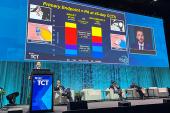In-Hospital Stroke Requires a Rethink: AHA
“Nobody is typically thinking stroke,” says Amre Nouh, and that leads to delays in treating events that occur in the hospital.

The diagnosis, evaluation, and treatment of stroke in patients hospitalized for another condition is frequently slower than in those who present to the emergency department, resulting in worse outcomes, but a new scientific statement from the American Heart Association (AHA) aims to raise awareness about this high-risk group.
“It’s a different patient population,” Amre Nouh, MD (University of Connecticut, Hartford), the statement’s lead author, told TCTMD. “It’s more challenging. These are folks hospitalized for a different medical illness, yet during the course of their hospital stay they develop stroke symptoms. Typically, most patients are not under the care of a neurology team or neurology-trained nurses. The team’s primary focus is the patient’s chief complaint, like chest pain, a gastrointestinal bleed, or liver failure. Nobody is typically thinking stroke.”
Almost paradoxically, having a stroke in the hospital surrounded by doctors and nurses, as opposed to outside the hospital, is associated with higher risks of morbidity and mortality. However, the patients are typically much sicker than community-onset populations.
Unlike community-onset stroke, with its established protocols and alert systems that trigger a rapid response, there is no one standard in place for screening, evaluating, and managing patients who have a neurological event in the hospital. In the hospital setting, the process needed to get the train moving for stroke takes longer, said Nouh. There are delays recognizing symptoms, with neurologists unlikely to be the first responder when a patient is showing difficulty after emerging from a procedure.
The scientific statement was published online Wednesday in Stroke ahead of a dedicated session at the International Stroke Conference.
Like All Stroke, Rapid Response Is Key
To date, there have been no large, validated studies to identify variables that increase the risk of stroke for hospitalized patients, but those hospitalized for a cardiovascular diagnosis are at higher risk for events. Data suggest that roughly 50% of in-hospital strokes occur after a cardiac or neurovascular procedure, such as CABG surgery, TAVI, cerebral angiography, carotid stenting, or endarterectomy. Other risk factors are hospitalization for infective endocarditis, arterial dissection, ACS with intracardiac thrombus, and unstable blood pressure, among others.
All the major therapies, including IV thrombolysis and mechanical thrombectomy, have been developed and tested in randomized controlled trials of patients with community-onset stroke evaluated in the emergency department. Research in the area of in-hospital stroke is extremely limited, likely because it’s a relatively rare event. In the United States, anywhere from 35,000 to 75,000 patients each year have a stroke while admitted for another diagnosis, although that figure likely underestimates the true incidence. Put another way, roughly 2% to 4% of all strokes occur during a hospitalization.
The team’s primary focus is the patient’s chief complaint, like chest pain, a gastrointestinal bleed, or liver failure. Nobody is typically thinking stroke. Amre Nouh
“In-hospital stroke does happen and when it does happen, we just deal with it and try to figure it out,” said Nouh, who is the system director of stroke and cerebrovascular disease at Hartford HealthCare. “The data is limited to case series and independent experiences as there is no consensus, no best practices, and marked variability in resources and expertise. And it’s an area, unfortunately, that is fraught with a lot of complexity.”
To optimize the evaluation and management of in-hospital stroke patients, the AHA recommends a standardized protocol to reduce delays and improve the treatment response:
- Ongoing education for all staff to recognize symptoms of stroke and how to active a stroke alert
- Creation of in-hospital stroke teams so that patients are cared for in a consistent manner
- Development of written protocols to expedite treatment and ensure consistent care—necessary resources may include expedited transport, access to rapid imaging, thrombolytic drug availability, and staffing capable of providing fast medical/endovascular/surgical treatment at any time
- Identification of barriers within the hospital or healthcare system—a pathway for interfacility transfer should be established when appropriate
- Examination of in-hospital stroke performance and quality data in order to enhance quality-improvement efforts—reporting in-hospital stroke cases to a registry may also help monitoring the true incidence of in-hospital stroke and provide data for future research
A major challenge with in-hospital stroke is that the time from symptom onset to triggering the alert is delayed because the symptoms may be attributed to other factors, resulting in a cascading delay in diagnosis and treatment. Like community-onset stroke, there are mimics of these neurological events. For example, toxic/metabolic encephalopathy and infections/sepsis can also result in impaired mental status. The use of sedative medications (particularly opioids and benzodiazepines), seizure, and syncope are common stroke mimics. Respiratory disorders, dementia with acute delirium, hypotension, and hypertensive emergency also can mimic stroke in the hospital.
To diagnose a stroke, brain imaging is required, but getting the patient to the scanner rapidly can be more complicated when the stroke occurs in the hospital, said Nouh.
‘No Single Magic Solution’
In terms of time lines, a stroke alert should be started in less than 5 minutes after symptom discovery, and a response team with neurologic expertise should arrive within 5 minutes of receiving the alert. Brain imaging should be started within 15 minutes of the stroke team’s arrival, and the images should be interpreted within 20 minutes of the scan. Intravenous thrombolysis should be started within 60 minutes of symptom onset, and endovascular treatment within 75 minutes. If those intervals can’t be met, then a dedicated improvement effort is recommended.
Regarding treatment, the statement reminds physicians that patients with suspected in-hospital stroke require acute management according to the AHA/American Stroke Association guidelines. For centers unable to provide that care—IV thrombolysis and endovascular treatments are evidence-based interventions for acute ischemic stroke—then they need to identify potential barriers to treatment and/or develop pathways to expedite transfer to a higher level of care.
Of the approximately 6,000 hospitals in the US, roughly 1,700 are accredited stroke centers. Accreditation applies to hospitals designated “acute stroke ready,” which are those that can provide IV thrombolysis and CT imaging along with acute neurologic expertise, as well as those classified as “comprehensive stroke centers” with dedicated stroke units and neuro-ICUs capable of providing a full range of care and treatment.
To TCTMD, Nouh said the goal of the scientific statement is to bring to the forefront that patients with in-hospital stroke are a high-risk population and to ensure that hospitals are equipped to take care of this group. “There’s no single magic solution to this,” he said. “What we hope this scientific statement does is to provide a framework, spur interest, and empower providers to elevate the importance of this topic so that more research continues,” he said. “We hope it’s a scaffold for more studies and more high-quality data to come out on the topic.”
Michael O’Riordan is the Managing Editor for TCTMD. He completed his undergraduate degrees at Queen’s University in Kingston, ON, and…
Read Full BioSources
Nouh A, Amin-Hanjani S, Furie KL, et al. Identifying best practices to improve evaluation and management of in-hospital stroke: a scientific statement from the American Heart Association. Stroke. 2022;Epub ahead of print.
Disclosures
- Nouh reports a research grant/honoraria from Genentech and ownership interest in/consulting for Openwater.





Comments